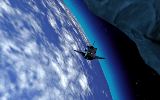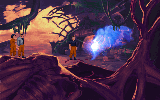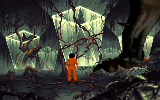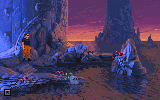 From the introduction cut-scene and
characters' first dialogs it becomes clear that someone's genius hands have touched The
Dig while in development. And then, after peeking in the CD folder,-- surprise!--
Sean Clark and Steven Spielberg contributed to the scripts, development, and the idea of
the game! Originally plotted by Spielberg as a story combining two films, Forbidden Planet
and Treasure of the Sierra Madre, The Dig finally materialized as a multimedia
adventure game with dialogs by Sean Clark and science-fiction author Orson Scott Card. And
this is only how The Dig began... The introduction throws the player right in the action: an Asteroid
Attila, which suddenly appeared in orbit around the Earth, threatens the world population
with unavoidable collision in the near future. Your alter ego is Commander Boston
Low, who together with geologist Ludger Brink, and journalist Maggie Robbins, form NASA's
team for a mission to detonate Attila, blow it off its deadly path and save the world. But
no one had enough imagination to predict what the mission would turn into. The giant piece
of rock appears to be an alien crystal-like spaceship, taking the trapped human team to
the abandoned planet on the other side of reality. Being safely transported to an unknown
alien world, but unable to stay together in the ever-changing fantastic world, your team
breaks up. Because Maggie seeks independence (like all women) and leaves, and Brink dies
stupidly, soon you are on your own, struggling to explore and understand the new,
mind-twisting surroundings. But nothing is the same in this world -- neither the illusive
loneliness, nor the meaning of life and death ... only your exploration can reveal the
essence of the unknown. From the introduction cut-scene and
characters' first dialogs it becomes clear that someone's genius hands have touched The
Dig while in development. And then, after peeking in the CD folder,-- surprise!--
Sean Clark and Steven Spielberg contributed to the scripts, development, and the idea of
the game! Originally plotted by Spielberg as a story combining two films, Forbidden Planet
and Treasure of the Sierra Madre, The Dig finally materialized as a multimedia
adventure game with dialogs by Sean Clark and science-fiction author Orson Scott Card. And
this is only how The Dig began... The introduction throws the player right in the action: an Asteroid
Attila, which suddenly appeared in orbit around the Earth, threatens the world population
with unavoidable collision in the near future. Your alter ego is Commander Boston
Low, who together with geologist Ludger Brink, and journalist Maggie Robbins, form NASA's
team for a mission to detonate Attila, blow it off its deadly path and save the world. But
no one had enough imagination to predict what the mission would turn into. The giant piece
of rock appears to be an alien crystal-like spaceship, taking the trapped human team to
the abandoned planet on the other side of reality. Being safely transported to an unknown
alien world, but unable to stay together in the ever-changing fantastic world, your team
breaks up. Because Maggie seeks independence (like all women) and leaves, and Brink dies
stupidly, soon you are on your own, struggling to explore and understand the new,
mind-twisting surroundings. But nothing is the same in this world -- neither the illusive
loneliness, nor the meaning of life and death ... only your exploration can reveal the
essence of the unknown.

 For The Dig, graphics and sound
are the most important components of the game, because it is an exploration of the new
world, and you are expected to get to know and understand through observation how even the
weirdest processes occur. That is why the makers applied as much detail to objects and
surroundings as it seems possible. Generally, it looks like LucasArts used the same
graphical engine for The Dig, as for Full Throttle. That is, the characters are
cartoon-like, and everything else is like in a cartoon. The cut-scenes (they appear quite
often to please the eye) are state-of-the-art The game makers state that the rendering
scheme takes longer but yields more realistic highlights and shadows. True, though it
added extra time for my 2X CD-ROM to load new environments and made me stare at the blank
screen a little longer. On the other hand the sound is truly great. While you move along
the story line, full digital sound follows you, and mystical yet realistic sounds can be
heard when you perform some extraordinary actions. For The Dig, graphics and sound
are the most important components of the game, because it is an exploration of the new
world, and you are expected to get to know and understand through observation how even the
weirdest processes occur. That is why the makers applied as much detail to objects and
surroundings as it seems possible. Generally, it looks like LucasArts used the same
graphical engine for The Dig, as for Full Throttle. That is, the characters are
cartoon-like, and everything else is like in a cartoon. The cut-scenes (they appear quite
often to please the eye) are state-of-the-art The game makers state that the rendering
scheme takes longer but yields more realistic highlights and shadows. True, though it
added extra time for my 2X CD-ROM to load new environments and made me stare at the blank
screen a little longer. On the other hand the sound is truly great. While you move along
the story line, full digital sound follows you, and mystical yet realistic sounds can be
heard when you perform some extraordinary actions.

The user interface design is extremely friendly, so to say. All you
need in the game is your inventory list and "save/load game" menu, which you can
pop on the screen by right-clicking the mouse or pressing F1 correspondingly. The
inventory contains the "device" for communicating with other team members, so
the total control really narrows down to two "clicks". The inventory looks like
a huge table, so you can see all of the collected objects at once. To use an object, just
carry it out of the inventory field and it will be highlighted when carried over something
where it can be used. Plain and simple!

Being what a huge adventure/exploration game is, The Dig is
no joke even for experienced players. It's hard to escape those moments of senseless
wandering in the alien underground caves until 3 in the morning, when you suddenly realize
that all you had to do is use your head and a bit of extraterrestrial logic. When I first
started playing The Dig, I was perceiving the action from the observer's
position. However, as the story advanced, I found myself looking at things from Commander
Low's point of view, putting myself in his place and executing the next logical action
that could help ME find the next answer to an alien puzzle. All in all, fascinating
graphics, endless caves and rooms and all those "unreal world" movie sequences
make The Dig a great experience for those looking for a big, serious adventure
game.
Pros: A great Spielbergian idea, a wonderful
story, characters and dialogs by Sean Clark and the rest of the "genius crew".
Imaginative special effects and fantastic sound throughout the whole game.
Cons: The graphics ran a little too slow on a
2X CD-ROM machine with 8MB RAM. I would strongly recommend a Pentium system with a 4X.
Some puzzles may seem too hard for starters. It is not a game for impatient players as you
have to live in it.
--Andrew Morozov |

 From the introduction cut-scene and
characters' first dialogs it becomes clear that someone's genius hands have touched The
Dig while in development. And then, after peeking in the CD folder,-- surprise!--
Sean Clark and Steven Spielberg contributed to the scripts, development, and the idea of
the game! Originally plotted by Spielberg as a story combining two films, Forbidden Planet
and Treasure of the Sierra Madre, The Dig finally materialized as a multimedia
adventure game with dialogs by Sean Clark and science-fiction author Orson Scott Card. And
this is only how The Dig began... The introduction throws the player right in the action: an Asteroid
Attila, which suddenly appeared in orbit around the Earth, threatens the world population
with unavoidable collision in the near future. Your alter ego is Commander Boston
Low, who together with geologist Ludger Brink, and journalist Maggie Robbins, form NASA's
team for a mission to detonate Attila, blow it off its deadly path and save the world. But
no one had enough imagination to predict what the mission would turn into. The giant piece
of rock appears to be an alien crystal-like spaceship, taking the trapped human team to
the abandoned planet on the other side of reality. Being safely transported to an unknown
alien world, but unable to stay together in the ever-changing fantastic world, your team
breaks up. Because Maggie seeks independence (like all women) and leaves, and Brink dies
stupidly, soon you are on your own, struggling to explore and understand the new,
mind-twisting surroundings. But nothing is the same in this world -- neither the illusive
loneliness, nor the meaning of life and death ... only your exploration can reveal the
essence of the unknown.
From the introduction cut-scene and
characters' first dialogs it becomes clear that someone's genius hands have touched The
Dig while in development. And then, after peeking in the CD folder,-- surprise!--
Sean Clark and Steven Spielberg contributed to the scripts, development, and the idea of
the game! Originally plotted by Spielberg as a story combining two films, Forbidden Planet
and Treasure of the Sierra Madre, The Dig finally materialized as a multimedia
adventure game with dialogs by Sean Clark and science-fiction author Orson Scott Card. And
this is only how The Dig began... The introduction throws the player right in the action: an Asteroid
Attila, which suddenly appeared in orbit around the Earth, threatens the world population
with unavoidable collision in the near future. Your alter ego is Commander Boston
Low, who together with geologist Ludger Brink, and journalist Maggie Robbins, form NASA's
team for a mission to detonate Attila, blow it off its deadly path and save the world. But
no one had enough imagination to predict what the mission would turn into. The giant piece
of rock appears to be an alien crystal-like spaceship, taking the trapped human team to
the abandoned planet on the other side of reality. Being safely transported to an unknown
alien world, but unable to stay together in the ever-changing fantastic world, your team
breaks up. Because Maggie seeks independence (like all women) and leaves, and Brink dies
stupidly, soon you are on your own, struggling to explore and understand the new,
mind-twisting surroundings. But nothing is the same in this world -- neither the illusive
loneliness, nor the meaning of life and death ... only your exploration can reveal the
essence of the unknown.